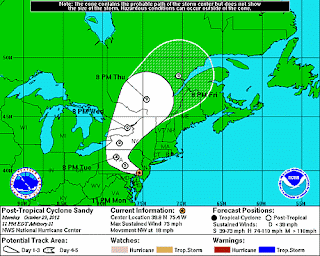Sandy Studies

The clock says, "Hoboken lost power at 9:05." Or so. City clocks are always off a bit. A Hoboken City Clock at 11th and Washington It's like a mystery novel. The detective looks down at the body on the ground, and his eyes scan to the wrist; the watch has struck some object during the fall; it's broken; the time stopped. Ah ha, that's when . . . 9:05 is about right. I was laying in bed writing an essay on the history of regulation and technological change when lights went out. It was unsettling to open my laptop right now for this blog post. All of my work was still awake and waiting for me, as it was when I put the laptop to sleep when the power died, like nothing at all has happened. But it has. We know now that the electricity systems went down when the surge hit. Just about then, water began pouring into my colleagues house. Just about then, the streets on the south end of town became lakes. And just about then, the electrical substation on the backside of tow...







